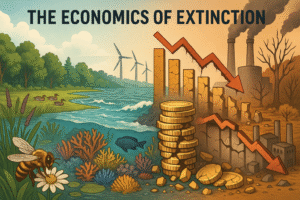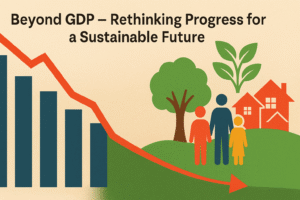Did you know that a 1% change in interest rates can swing billions of dollars in the stock market? That’s the fascinating interplay between finance and the economy in action.
Introduction
When we think about making investment decisions, it’s easy to get lost in the whirlwind of stock prices, mutual funds, and market charts. However, behind these movements lies a powerful force: the economy. Understanding how macroeconomic trends—like GDP (Gross Domestic Product) growth, inflation, and unemployment—influence financial markets can give investors a crucial edge. In this blog, we’ll delve into this intersection of finance and economy, illustrating how these large-scale trends shape investment strategies.
The Role of GDP Growth in Investment Decisions
Gross Domestic Product (GDP) measures a country’s economic output and serves as a key indicator of its overall health. A rising GDP typically signals economic expansion, boosting investor confidence.
Example: The post-pandemic recovery in 2021 saw GDP growth in countries like India and the US, driving a surge in equity markets. Sectors like technology and consumer goods benefited as companies projected higher revenues due to increased consumer spending.
For individual investors, monitoring GDP trends can highlight opportunities in sectors poised to grow. For instance, a booming GDP may make cyclical stocks—those tied closely to the economy—attractive.

Inflation’s Double-Edged Sword
Inflation—the rise in general price levels—affects purchasing power and investment returns. Moderate inflation often signals a growing economy, but excessive inflation can erode savings and trigger higher interest rates.
Case Study: In the late 1970s, the US experienced “stagflation” (a combination of stagnation and inflation). Investors fled to gold, a traditional inflation hedge, as equities and bonds suffered.
Today, central banks, such as the Reserve Bank of India (RBI), combat inflation using monetary policies. Investors keen on navigating inflationary periods can focus on inflation-indexed bonds or sectors like energy and commodities.
Interest Rates: The Economic Compass
Interest rates, set by central banks, are a pivotal macroeconomic tool. They influence borrowing costs, consumer spending, and corporate profitability.
Example: When the Federal Reserve (the central bank of the US) cut interest rates to near-zero during the COVID-19 pandemic, it fueled a surge in tech stocks. Companies like Apple and Tesla benefited from cheap credit, enabling growth.
For investors, low-interest-rate environments are favourable for equities and real estate, while rising rates often boost fixed-income securities like bonds.
Unemployment Trends and Market Movements
Unemployment rates reflect the strength of the labour market and, indirectly, consumer spending capacity. High unemployment often dampens economic activity, whereas low unemployment can spur growth.
Anecdote: During the 2008 financial crisis, the spike in unemployment significantly impacted retail and real estate stocks as consumers cut back on spending. Conversely, post-crisis recovery led to booming e-commerce companies like Amazon, which adapted to changing consumer behaviour.
Investors should watch unemployment data to gauge sectors that may outperform. For example, a drop in unemployment could signal growth in discretionary spending industries like travel and entertainment.
Currency Exchange Rates: The Global Impact
In our interconnected world, currency fluctuations have a profound effect on investments, particularly for multinational companies and export-oriented sectors.
Example: A stronger US dollar in recent years made exports more expensive, impacting companies like Boeing (a leading aircraft manufacturer). On the other hand, a weaker Indian rupee often benefits the IT sector as firms earn revenues in dollars.
Investors trading internationally or investing in foreign stocks need to account for currency risks and opportunities.
Government Policies and Fiscal Measures
Fiscal policies, including taxation and public spending, play a significant role in shaping investment landscapes. During economic downturns, governments may introduce stimulus packages to boost spending.
Case Study: India’s 2020 Atmanirbhar Bharat (Self-Reliant India) package included measures to support MSMEs (Micro, Small, and Medium Enterprises), creating opportunities in the banking and industrial sectors.
Investors can align their portfolios with government initiatives, such as renewable energy subsidies or infrastructure development, to capitalize on emerging trends.
Conclusion
Macroeconomic trends form the backbone of financial markets, shaping opportunities and risks for investors. By understanding indicators like GDP, inflation, and interest rates, individuals can make informed decisions and align their strategies with economic realities.
So, the next time you’re planning your investments, don’t just look at the numbers on a chart. Take a step back and consider the bigger picture—the economy itself. After all, being financially savvy means staying economically aware.
Author’s Note
As a financial enthusiast, my goal is to make complex economic concepts accessible and actionable for everyone. Remember, the more you know about the economy, the better your financial decisions will be. Let’s keep learning together!
G.C., Ecosociosphere contributor.





Comments
You have brought up a very fantastic points, thanks for the post.
Thank you for the auspicious writeup It in fact was a amusement account it Look advanced to far added agreeable from you However how can we communicate
Just wish to say your article is as surprising The clearness in your post is just cool and i could assume youre an expert on this subject Fine with your permission allow me to grab your RSS feed to keep updated with forthcoming post Thanks a million and please keep up the enjoyable work